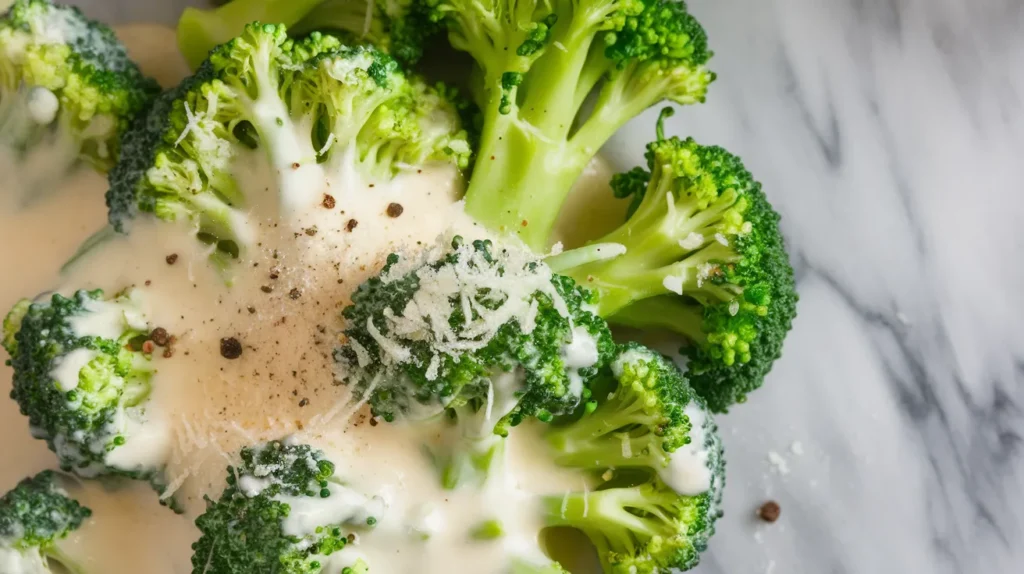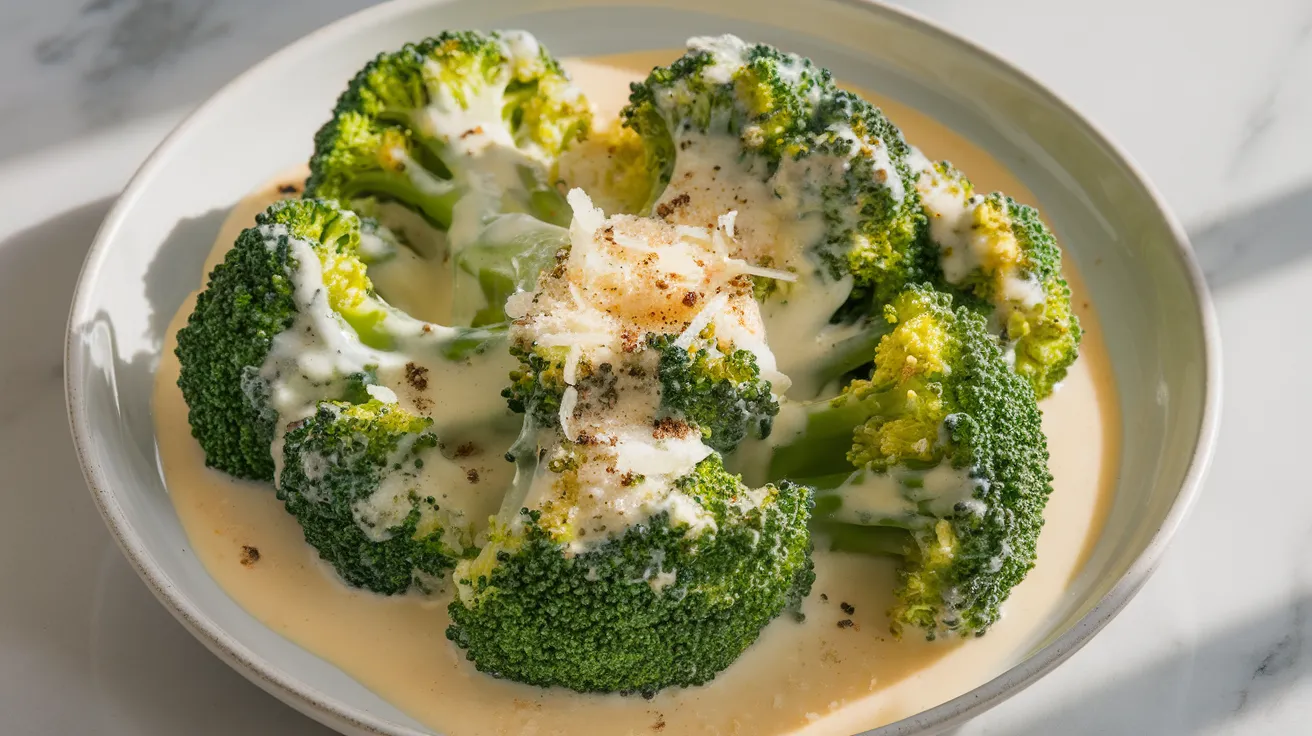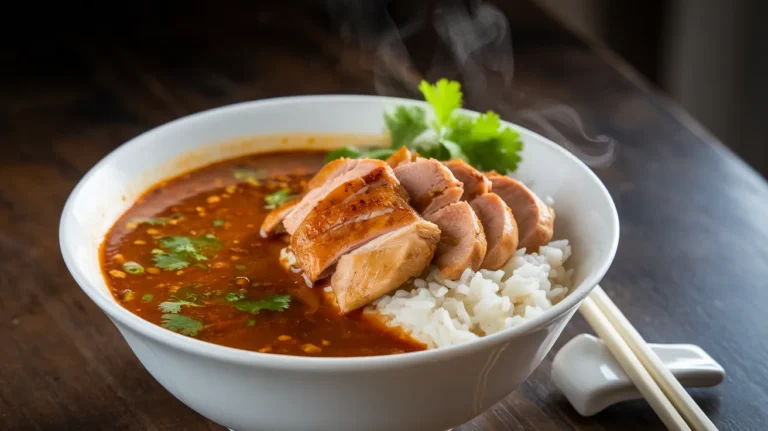This rich and velvety sauce for broccoli transforms ordinary vegetables into an irresistible side dish that even picky eaters will love. Our foolproof sauce for broccoli combines simple pantry ingredients to create a restaurant-quality dish that’s ready in just 25 minutes and perfect for busy weeknight dinners.
SERVES: 4 | PREP: 10 MIN | COOK: 15 MIN | TOTAL: 25 MIN
Ingredients
For the Sauce Base
| Ingredient | Amount |
|---|---|
| Unsalted butter | 4 tablespoons |
| All-purpose flour | 2 tablespoons |
| Whole milk | 1 cup |
| Heavy cream | ¼ cup |
Flavor Components
| Ingredient | Amount |
|---|---|
| Fresh garlic | 3 cloves, minced |
| Parmesan cheese | ½ cup, freshly grated |
| Salt | ½ teaspoon |
| Black pepper | ¼ teaspoon |
| Nutmeg | Pinch |
For the Broccoli
| Ingredient | Amount |
|---|---|
| Fresh broccoli | 1½ pounds, cut into florets |
| Salt | 1 teaspoon (for boiling water) |
Detailed Step-by-Step Instructions for Sauce for Broccoli
Phase 1: Preparing Perfect Broccoli (8 minutes)
Step 1: Set Up Your Cooking Station Fill a large pot (at least 4-quart capacity) with water, leaving about 2 inches from the rim. Add 1 teaspoon salt – this seasons the broccoli and helps maintain its bright green color. Place the pot on your stove’s largest burner and turn heat to high. Cover with a lid to speed up the boiling process.
Beginner Tip: Salt water boils at a higher temperature, which means your broccoli will cook more evenly and retain better texture.
Step 2: Prepare Your Broccoli Properly While waiting for water to boil, rinse 1½ pounds fresh broccoli under cold running water. Using a sharp knife, cut the broccoli into uniform florets about 2 inches wide and 1½ inches tall. Don’t throw away the stems! Peel the tough outer layer with a vegetable peeler and slice stems into ½-inch rounds – they’re delicious and cook at the same rate as florets.
Why This Matters: Uniform pieces ensure everything cooks evenly, preventing some pieces from being mushy while others stay too firm.
Step 3: Test for Proper Boiling Your water is ready when you see rapid, vigorous bubbles breaking the surface consistently. This usually takes 5-7 minutes depending on your stove. If you only see small bubbles around the edges, wait longer – gentle simmering won’t cook broccoli properly.
Step 4: Cook Broccoli to Perfection Carefully add all broccoli pieces to the boiling water at once. Don’t worry if the boiling stops temporarily – this is normal. The water will return to a boil within 30-60 seconds. Set a timer for 3 minutes immediately. Stir gently with a wooden spoon after 1 minute to ensure even cooking.
Visual Cue: Properly cooked broccoli turns bright emerald green and feels tender when pierced with a fork, but still offers slight resistance.
Step 5: Perfect the Drain When timer rings, immediately drain broccoli in a colander placed in your sink. Shake the colander gently to remove excess water, but don’t rinse with cold water – warm broccoli helps the sauce adhere better. Set aside while you make your sauce.
Common Mistake: Never leave broccoli sitting in hot water after cooking time ends, or it will continue cooking and become mushy.
Phase 2: Creating the Sauce Foundation (5 minutes)
Step 6: Start Your Roux Base In a medium heavy-bottomed saucepan (2-3 quart size), place 4 tablespoons unsalted butter over medium heat – not medium-high, just medium. Watch the butter carefully as it melts. You’ll hear gentle sizzling when it’s ready. The butter should melt smoothly without browning or bubbling aggressively.
Temperature Guide: If butter starts smoking or turning brown, your heat is too high. Remove from heat for 30 seconds and reduce temperature.
Step 7: Add Aromatic Garlic Add 3 cloves minced garlic (about 1 tablespoon) to the melted butter. Stir constantly with a wooden spoon or whisk for exactly 30-45 seconds. The garlic should smell fragrant and soften slightly but never turn brown or golden. If it starts browning, remove pan from heat immediately.
Why 30 Seconds Matters: Raw garlic tastes harsh, but overcooked garlic becomes bitter and can ruin your entire sauce.
Step 8: Create the Thickening Agent Sprinkle 2 tablespoons all-purpose flour evenly over the butter-garlic mixture. Immediately begin whisking in small circular motions, making sure to reach all corners of the pan. Continue whisking constantly for 90 seconds to 2 minutes. The mixture (called a roux) should bubble gently and smell slightly nutty, not raw or floury.
Visual Check: Your roux is ready when it’s smooth, paste-like, and light golden in color. It should coat your whisk evenly without any dry flour spots.
Phase 3: Building the Creamy Sauce Base (6 minutes)
Step 9: Add Liquid Gradually (Critical Step) Remove your pan from heat temporarily. Measure 1 cup whole milk in a liquid measuring cup. Starting with just 2 tablespoons, pour milk into the roux while whisking vigorously. The mixture will look thick and pasty at first – this is completely normal. Return pan to medium heat.
Beginner Success Tip: Adding liquid slowly prevents lumps. If mixture seems too thick to whisk, add another tablespoon of milk.
Step 10: Continue Building Smooth Base Add remaining milk in ¼ cup increments, whisking constantly between each addition. Wait until each addition is fully incorporated before adding more. The sauce will gradually become smooth and creamy. This process takes patience but prevents lumps from forming.
Troubleshooting: If lumps appear, remove from heat and whisk vigorously for 30 seconds. Most small lumps will dissolve with aggressive whisking.
Step 11: Add Richness with Cream Pour in ¼ cup heavy cream and whisk until completely combined. The sauce should now look smooth, pale, and creamy. If you see any lumps at this point, strain the sauce through a fine-mesh sieve back into the pan.
Step 12: Achieve Perfect Consistency Bring sauce to a gentle simmer – you should see small bubbles breaking the surface occasionally, not aggressive boiling. Cook for 3-4 minutes, whisking every 30 seconds. The sauce is ready when it coats the back of a wooden spoon and doesn’t immediately drip off when lifted.
Consistency Test: Dip a spoon in sauce, run your finger across the back – the line should stay clear for 2-3 seconds before sauce flows back together.
Phase 4: Final Flavoring and Assembly (4 minutes)
Step 13: Add Cheese and Seasonings Remove sauce from heat completely. Add ½ cup freshly grated parmesan cheese, ½ teaspoon salt, ¼ teaspoon black pepper, and a small pinch of nutmeg. Whisk until cheese melts completely and sauce becomes smooth and glossy, about 30-45 seconds.
Cheese Tip: Off-heat addition prevents cheese from becoming stringy or grainy. Fresh-grated melts much better than pre-shredded.
Step 14: Taste and Adjust Using a clean spoon, taste your sauce carefully (it’s hot!). The flavor should be creamy, cheesy, and well-balanced. Add more salt if needed, or extra pepper for warmth. If sauce tastes flat, add 1-2 tablespoons more parmesan.
Step 15: Combine with Broccoli Add the warm, drained broccoli to your sauce and fold gently with a large spoon or rubber spatula. Make sure every floret gets coated with the creamy sauce. The residual heat will warm everything through perfectly.
Step 16: Final Presentation Transfer to a warmed serving bowl immediately. The sauce for broccoli should look glossy and coat each floret completely without being too thick or thin. Serve within 2-3 minutes for optimal texture and temperature.
Chef’s Notes for Perfect Sauce for Broccoli
• Heat Management: This sauce for broccoli requires gentle, consistent heat. High temperatures cause dairy to curdle and cheese to become stringy.
• Fresh Ingredients: Always use freshly grated parmesan and fresh garlic for the best flavor in your sauce for broccoli.
• Timing Strategy: Start cooking broccoli first, then immediately begin sauce preparation. This ensures both components finish simultaneously.
• Texture Recovery: If your sauce for broccoli becomes too thick, gradually whisk in warm milk one tablespoon at a time until desired consistency returns.
Nutrition Information (Per Serving)
- Calories: 185
- Protein: 8g
- Carbohydrates: 12g
- Fat: 13g
- Fiber: 4g
- Sodium: 380mg
Creative Sauce for Broccoli Variations
Herb-Infused Sauce for Broccoli
Add 2 tablespoons fresh lemon juice and 1 tablespoon chopped fresh thyme to create a brighter flavor profile. This variation complements other vegetable dishes like our sauce for asparagus beautifully.
Spicy Cheese Sauce for Broccoli
Incorporate ¼ teaspoon red pepper flakes and 1 teaspoon Dijon mustard for adults who enjoy heat with their vegetables.
Bacon-Enhanced Sauce for Broccoli
Cook 3 strips bacon until crispy, reserve 1 tablespoon bacon fat, and crumble bacon into finished sauce for smoky richness.
Mushroom Lover’s Sauce for Broccoli
Sauté ½ cup sliced mushrooms with garlic in step 7 for an earthy twist that pairs wonderfully with our sauce for Brussels sprouts recipe.
Storage & Reheating Your Sauce for Broccoli
Refrigerator Storage: Store leftover sauce separately from broccoli for up to 3 days in an airtight container.
Proper Reheating: Warm sauce gently over low heat, whisking in 1-2 tablespoons warm milk to restore smooth consistency. Never use high heat or microwave.
Make-Ahead Strategy: Prepare sauce base through step 12, then refrigerate. Reheat gently and complete with cheese when ready to serve fresh broccoli.

Troubleshooting Common Sauce for Broccoli Problems
Problem: Lumpy, grainy sauce texture Solution: Remove from heat immediately and whisk vigorously for 60 seconds. For stubborn lumps, strain sauce through fine-mesh sieve, then return to pan and continue.
Problem: Sauce for broccoli too thin and watery Solution: Continue simmering gently until thickened, or create slurry with 1 teaspoon cornstarch mixed with 1 tablespoon cold milk and whisk in.
Problem: Overly thick, pasty consistency Solution: Gradually whisk in warm milk 1 tablespoon at a time until proper coating consistency returns.
Problem: Broken or curdled appearance Solution: Heat was too high. Remove from heat, add 2 tablespoons cold heavy cream, and whisk vigorously while sauce cools slightly.
Problem: Bland, underseasoned flavor Solution: Increase salt gradually, add more parmesan, or brighten with 1 teaspoon lemon juice. Always taste and adjust before serving.
Essential Equipment for Sauce for Broccoli Success
• Heavy-bottomed saucepan (2-3 quart) – prevents scorching and hot spots • Wire whisk – creates smooth, lump-free sauce texture • Large pot (4+ quart) – for properly cooking broccoli • Fine-mesh colander – for draining vegetables thoroughly • Sharp chef’s knife – for cutting uniform broccoli florets • Liquid measuring cup – for accurate milk measurement • Wooden spoon – for gentle folding and tasting
Organized Shopping List
Dairy Section
- Unsalted butter (1 stick)
- Whole milk (1 cup needed)
- Heavy cream (small carton)
- Fresh parmesan cheese block (for grating)
Produce Section
- Fresh broccoli crowns (1½ pounds)
- Fresh garlic (1 head)
Pantry/Baking Aisle
- All-purpose flour
- Fine sea salt
- Black pepper (whole peppercorns preferred)
- Ground nutmeg
Professional Success Secrets
1. Always use room temperature dairy ingredients to prevent sauce from seizing when combined with hot roux base.
2. Whisk constantly and vigorously when adding liquids – this single technique prevents 90% of sauce problems beginners encounter.
3. Invest in fresh parmesan and grate it yourself – pre-shredded cheese contains anti-caking agents that prevent smooth melting.
4. Cook broccoli until just tender-crisp, never soft – it continues cooking slightly when combined with hot sauce.
5. Master the gentle simmer technique for this sauce for broccoli – aggressive boiling causes dairy sauces to break and become grainy.




